Main menu
Common skin conditions

NEWS
Join DermNet PRO
Read more
Quick links
Transient acantholytic dermatosis — extra information
Transient acantholytic dermatosis
Last reviewed: May 2023
Author: Dr Amanda Oakley, Dermatologist, New Zealand, 1997 (further updates 2016, 2021)
Reviewing dermatologist: Dr Ian Coulson (2023)
Edited by the DermNet content department
Introduction
Demographics
Causes
Clinical features
Complications
Diagnosis
Differential diagnoses
Treatment
Prevention
Outlook
What is transient acantholytic dermatosis?
Transient acantholytic dermatosis, also known as Grover disease, is a common, acquired, itchy, truncal rash characterised by acantholysis on histopathology.
Transient acantholytic dermatosis

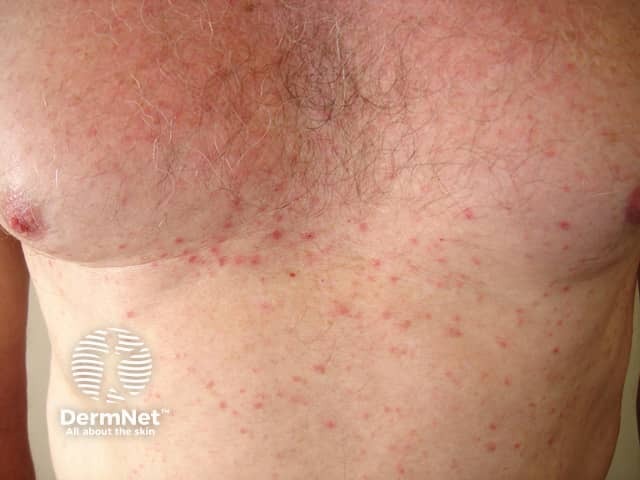
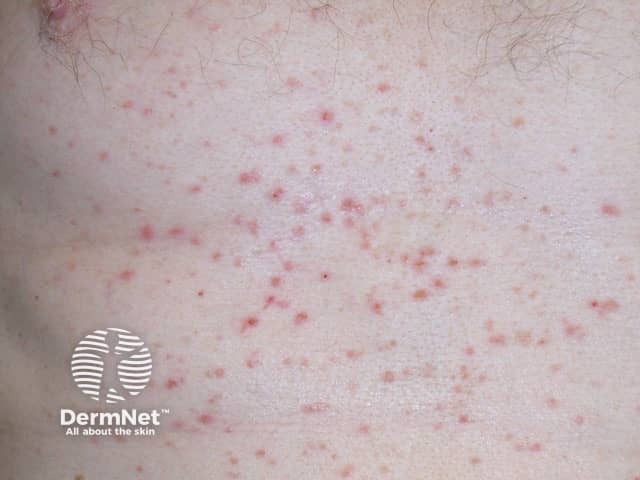
The typical scattered slightly rough red papules of Grover disease on the trunk can be seen in the images above.
Who gets transient acantholytic dermatosis?
Transient acantholytic dermatosis most often affects Caucasian men over 50 years of age with sundamaged skin (mean age at diagnosis 61 years). It is less common in skin of colour, women, and younger adults.
Risk factors include sun-exposure, sweating, fever, malignancy, and being hospitalised or bedridden. A Grover-like rash has been reported during the febrile phase of COVID-19.
Transient acantholytic dermatosis is increasingly reported with the use of BRAF-inhibitors such as vemurafenib and dabrafenib monotherapy, and cytotoxic chemotherapy drugs.
What causes transient acantholytic dermatosis?
The cause of transient acantholytic dermatosis is unknown. Due to the frequent association with skin occlusion, heat, and sweating, one theory suggests Grover disease is due to sweat duct damage and occlusion.
Drug-induced transient acantholytic dermatosis may be due to the drug or its metabolites being excreted in the sweat with toxic effects on the adjacent epidermis causing acantholysis and dyskeratosis. BRAF-induced Grover disease may result from keratinocyte proliferation via activation of the MAP-kinase pathway.
SARS-CoV-2 was demonstrated on immunohistochemistry in the sweat gland epithelium and dermal vessels in a patient with COVID-19.
What are the clinical features of transient acantholytic dermatosis?
Grover disease often starts quite suddenly. Some (but not all) studies report it is more common in winter than in summer.
- The most common sites affected are central back, mid chest, and upper arms.
- Lesions are small red, crusted, or eroded papules and vesicles
- The rash is typically intensely itchy.
Transient acantholytic dermatosis
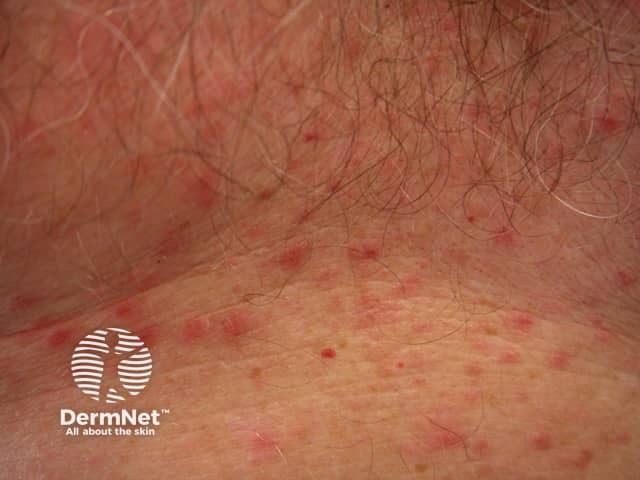
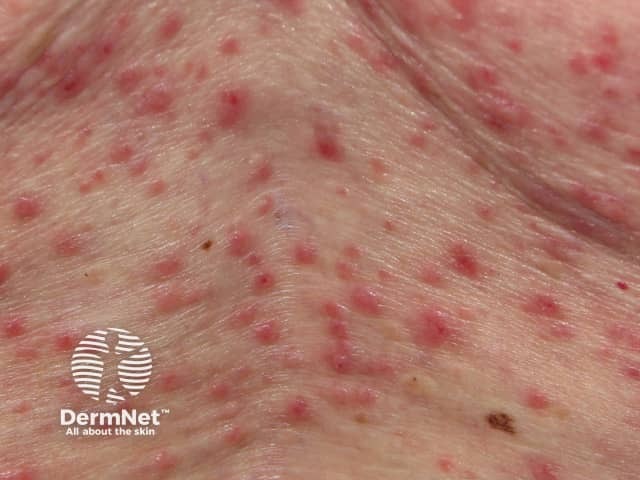
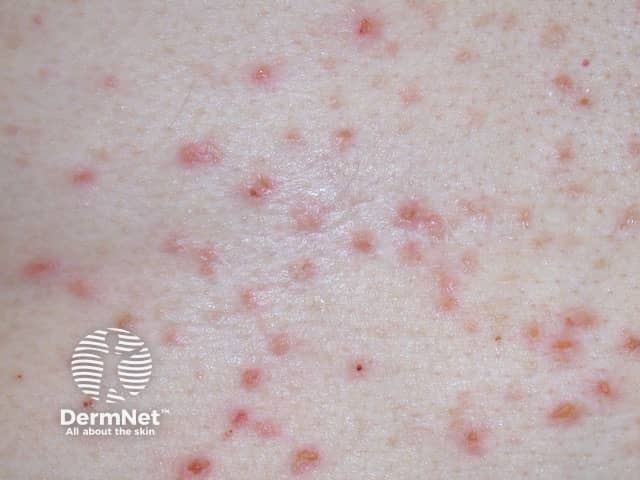
Images above are close up views of the slightly rough red papules of Grover disease on the chest.
See images of transient acantholytic dermatosis
What are the complications of transient acantholytic dermatosis?
Transient acantholytic dermatosis may be complicated by the development of dermatitis, usually in a discoid pattern with round or oval, dry or crusted plaques. The plaques start on the chest and back and may spread to affect the limbs.
How is transient acantholytic dermatosis diagnosed?
Transient acantholytic dermatosis is usually diagnosed clinically, but a skin biopsy may be necessary.
The pathology of transient acantholytic dermatosis is characteristic, with acantholysis (separated skin cells) with or without dyskeratosis (abnormal rounded skin cells). Spongiotic dermatitis may also be noted. Four histological patterns are recognised, not all of which show the classic acantholytic pattern.
What is the differential diagnosis for transient acantholytic dermatosis?
What is the treatment of transient acantholytic dermatosis?
There is no curative treatment for Grover disease, but the following suggestions may relieve the itch and hasten resolution.
- Remain cool, as sweating may induce more itchy spots.
- Moisturising creams or antipruritic lotions containing menthol and camphor can reduce the desire to scratch.
- Cryotherapy
- Topical trichloroacetic acid
- Apply a topical steroid, if possible as a lotion, to relieve itch.
- Topical steroid/vitamin D analogue combination ointment
- Oral retinoids (eg, acitretin)
- Phototherapy and photochemotherapy
How can transient acantholytic dermatosis be prevented?
Keep cool and wear garments designed to prevent sweat rash.
If using a BRAF-inhibitor, the addition of a MEK-inhibitor seems to protect against the development of transient acantholytic dermatosis.
What is the outlook for transient acantholytic dermatosis?
The duration of transient acantholytic dermatosis is variable although spontaneous self-resolution in 2-4 weeks is typical. It can come and go, often with a seasonal variation. Although it is called transient, Grover disease is often relapsing and can be chronic persisting for years.
Bibliography
- Beer J, Rosenbach M. Grover disease associated with chemotherapy: review of potential pathophysiology, current treatments, and future directions. J Drugs Dermatol. 2020;19(11):1056-64. doi:10.36849/JDD.2020.5648 PubMed
- Boix-Vilanova J, Gracia-Darder I, Saus C, et al. Grover-like skin eruption: another cutaneous manifestation in a COVID-19 patient. Int J Dermatol. 2020;59(10):1290-2. doi:10.1111/ijd.15104. Journal
- Galamgam J, Lee DJ. Treatment of transient acantholytic dermatosis with liquid nitrogen. JAAD Case Rep. 2020;6(4):341-343. Journal
- Singh AG, Tchanque-Fossuo CN, Elwood H, Durkin JR. BRAF inhibitor and hairy cell leukemia-related transient acantholytic dermatosis. Dermatol Online J. 2020;26(2):13030/qt3ps33564. Journal
- Weaver J, Bergfeld WF. Grover disease (transient acantholytic dermatosis). Arch Pathol Lab Med. 2009;133(9):1490-4. doi:10.5858/133.9.1490. Journal
On DermNet
- Transient acantholytic dermatosis pathology
- Images of transient acantholytic dermatosis
- Miliaria
- Scaly skin conditions
- Blistering skin conditions
- The differential diagnosis of itchy skin
